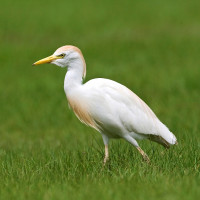Description
In the forest of Belle-Branch all the species of Woodpeckers from the department of Mayenne nest: Kara ağaçkakan, Yeşil Ağaçkakan, Orman alaca ağaçkakanı , Küçük ağaçkakan and Ortanca Ağaçkakan. You will also be able to observe the Gökçe delice nesting in the regenerating plots, where Çobanaldatan, Sarı kirazkuşu, Akgerdanlı ötleğen are also found. Look for the Kara çaylak and the Arı Şahini which are present in the area. On the pond of Curécy (private site) you will find during the breeding season the Küçük ak balýkçýl, the Elmabaş patka, the Tepeli patka, the Bahri, the Sakarmeke. You will hear the singing of the Sarıasma, the Üveyik and the Şarkıcı mukallit which can be observed around the pond. More occasionally, the Yelpaze Kuyruk and the Kızılsırtlı örümcekkuşu have already nestled on the site.
In the fall, look for migrating birds stopping over on the Curécy pond and its surroundings: Kara sinekkapan, Kındıra kamışçını, Boyunçeviren, Söğütbülbülü, Kara leylek , Balık kartalı and then depending on the water levels the shorebirds and waders are regular! More rare birds that have been observed are Sarıbacaklı kumkuşu, Benekli suyelvesi, Mavigerdan and many others.
In winter, many granivorous passerines come to feed on the site, note the presence of Kocabaş (also a breeder) and Dağ ispinozu. From the observatory you will be able to observe the Anatidae, maybe hear the Su kılavuzu shout. At the end of the day you can attend the Sığır balıkçılı dormitory gathering on the island of the pond.
In the spring watch for the pre-nuptial migrants, the first Kır kırlangıcı, Ev kırlangıcı, Kum kırlangıcı come to feed above the pond, not far away a Delice doğan could present itself for capture one while waiting for the emergence of the first dragonflies. The Balık kartalı migrates to reach its breeding site just like the Leylek. Take a look at the tail of the pond from the dike, maybe a Çıkrıkçın has stopped there.
_________________________
Français: Forêt domaniale de Belle-branche et l'étang de Curécy, un complexe de milieux bocagers et zones-humides. Plus de 230 espèces d'oiseaux y ont été observées. La forêt domaniale de Belle-branche, est principalement constitué de Hêtraie-chenaie où toutes les espèces de Pics du département de la Mayenne y nichent : Kara ağaçkakan, Yeşil Ağaçkakan, Orman alaca ağaçkakanı, Küçük ağaçkakan et Ortanca Ağaçkakan . Vous pourrez également observer le Gökçe delice nicheur dans les parcelles en régénération, où se trouvent aussi Çobanaldatan, Sarı kirazkuşu, Akgerdanlı ötleğen ... Cherchez le Kara çaylak et la Arı Şahini qui sont présent dans le secteur. Sur l'étang de Curécy (site privé) vous trouverez en période de reproduction l' Küçük ak balýkçýl, le Elmabaş patka, le Tepeli patka, le Bahri, la Sakarmeke ... Vous ne passerez pas à côté du chant du Sarıasma, de la Üveyik et de l' Şarkıcı mukallit qui sont observables autour de l'étang. Plus ponctuellement la Yelpaze Kuyruk et la Kızılsırtlı örümcekkuşu ont déjà niché sur le site.
A l'automne cherchez les migrateurs en halte sur l'étang de Curécy et ses pourtours : Kara sinekkapan, Kındıra kamışçını, Boyunçeviren, Söğütbülbülü, Kara leylek, Balık kartalı et puis selon les niveaux d'eau les limicoles et échassiers y sont réguliers ! Plus rarement y ont déjà été observés Sarıbacaklı kumkuşu, Benekli suyelvesi, Mavigerdan et bien d'autres ...
L'hiver de nombreux passereaux granivores viennent se nourrir sur le site notons la présence de Kocabaş (également nicheur) et de Dağ ispinozu. Depuis l'observatoire vous pourrez observer les anatidés, peut-être entendre crier le Su kılavuzu . En fin de journée vous pourrez assister au rassemblement du dortoir de Sığır balıkçılı sur l'île de l'étang.
Au printemps guettez les migrateurs pré-nuptiaux, les premières Kır kırlangıcı, Ev kırlangıcı, Kum kırlangıcı viennent se nourrir au dessus de l'étang, non loin un Delice doğan pourrait se présenter pour en capturer une en attendant l'émergence des premières libellules. Le Balık kartalı passe en migration pour rejoindre son site de reproduction tout comme la Leylek. Jettez un coup d'oeil en queue d'étang depuis la digue, peut-être qu'une Çıkrıkçın s'y est arrêté.
Details
Access
The site is located near the Meslay-du-Maine / Sablé-sur-Sarthe road axis. Park in the main car park along the D235, (click on the P in the map to get directions) then take the forest paths on foot and follow the footpath that leads to the ornithological observatory of Curécy to the south of the pond.
_________________________
Français: Le site se situe à proximité de l'axe routier Meslay-du-Maine/ Sablé-sur-Sarthe. Garez-vous sur le parking principal le long de la D235 (cliquez sur le P sur la carte pour obtenir les directions), puis empruntez à pied les allées forestières et suivez le sentier pédestre qui mène à l'observatoire ornithologique de Curécy au sud de l'étang.

.jpg)

.jpg)
